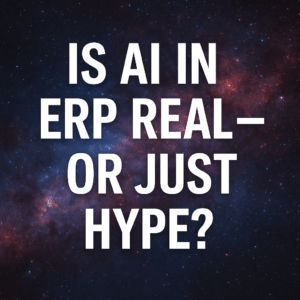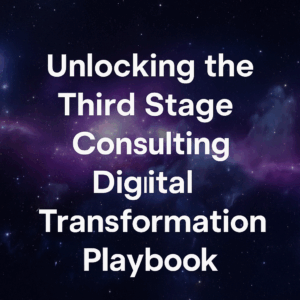Organizations generally struggle to unlock the value of their ERP implementations or digital transformations to their full potential. For many, it can be hard to deliver much more than mere incremental improvements as part of their transformations.
This problem isn’t necessarily due to lack of software capabilities. Though many are lacking the maturity of past legacy solutions, the current leading ERP and HCM systems such as S/4HANA, Oracle Cloud ERP, Microsoft Dynamics 365, and others contain advanced technologies that many will simply never be able to consume.
Table of Contents
ToggleThe technology versus organizational divide
In other words, the technology is changing and advancing at a much faster pace than our own organizations and people can. We simply can’t consume technology as fast as the ERP vendors are creating new capabilities – or least we can’t without a lot of difficulty along the way.
As a result, the outcome of most ERP implementations largely leads to disappointment. Organizations tend to struggle with:
- “Shelfware” and capabilities that are never realized
- Bloated implementation and software license costs
- Misaligned expectations of the transformation vs. what was actually delivered to the organization
- Employees that are overwhelmed and confused by new capabilities
- Focusing too much on getting technological capabilities in place versus building organizational capabilities, which are two different things
- “Agile” implementations that have left them with no cohesive or overarching transformation strategy
- Lack of benefits realization and ROI
Companies clearly struggle with bridging the gap between digital transformation vs. ERP implementation vs. business transformation. The good news is that it doesn’t have to be this way.
Defining the magnitude of change we want to deliver
It all begins with clearly understanding how much change and improvement we expect and think we can realistically deliver. Delivering a “quick hit” implementation with non-negotiable go-live dates (due to operational needs or sunsetting of a legacy product, for example) is very different than overhauling and optimizing our operating model and organizational design along the way.
This whiteboard video explains how to bridge this gap:
The problem is that internal expectations are very often misaligned. For example, executives may expect a complete overhaul of its target operating model as part of their transformation, but the implementation project team only has the time and resources to deliver a solution that simply automates old processes.
Build a transformation strategy and plan that is aligned with the expected magnitude of change
Once we have internal alignment on what the transformation will deliver, we need to ensure that our overarching digital strategy and project plan reflect the realities of what is required to deliver. If this is intended to be a technology uplift, then our plan should look much different than if we are expecting more of a quantum leap improvement to our operational model.
The problem is that most ERP vendors and their implementation partners attempt to prescribe a one-size-fits-all approach. Their “best practices” and canned implementation plans lead every organization implementing their software to assume that their transformation will look largely the same as the next guy’s. Be sure to take vendor implementation proposals with a grain of salt and tailor for your needs.
Leverage the technologies that best enable your expected digital transformation
The further you desire to push bigger changes as part of your transformation, the less likely it is that a single ERP system will deliver those capabilities. With this in mind, it is important to consider best of breed or third-party bolt-on solutions that best enable the changes and capabilities that you expect.
For example, if you are implementing S/4HANA and also expect to renovate your employee experience as part of the transformation, then you don’t need to choose Success Factors vs. Workday for your HCM solution simply because SAP owns the product. Another example: a manufacturer implementing Oracle Cloud or Microsoft D365 may want to augment the core ERP system with an MES system such a Rovisys to better enable its shop floor capabilities.
With today’s advanced integration tools, cramming everything into a single ERP system in the name of “single source of truth” is a relic of the past. Independent ERP consultants such as Third Stage can help navigate the technology landscape to help you determine the best solutions for your digital transformation.
Organizational change management is the key determining factor of digital transformation value
Regardless of where you fall on the change spectrum, change management will be the most critical factor to your digital transformation and ERP success. But a more aggressive transformation attempt will require even more organizational change management firepower and finesse than a more incremental approach.
With this in mind, the following change management activities become increasingly important the further along you are on the “degree of transformation change” spectrum:
- Clear definition of change impacts to the organization
- Time spent designed the future state target operating model
- Organizational design and defining new roles and responsibilities
- Aligning organizational changes with metrics from the business case
- Executive and stakeholder alignment and support
Think of your overall change strategy and plan as a dial: the bigger the change expected from your transformation, the more you will need to “turn up” the dial by investing more time and resources in change management activities.
Bottom Line: Clearly defining your degree of change is a critical first step to your digital transformation
Defining where you would like to land on the change spectrum is an important activity that most overlook early in their digital transformations. Without it, you won’t have internal alignment and an implementation strategy and plan that is aligned with those expectations. Rather than shooting in the dark and hoping for the best, take the time to get this part right.
I am happy to be a sounding board for any ideas you might be considering for your ERP implementation or digital transformation, so please feel free to contact me to arrange a time for a video or phone conference. I am happy to bounce around ideas on how to make your project more successful!





